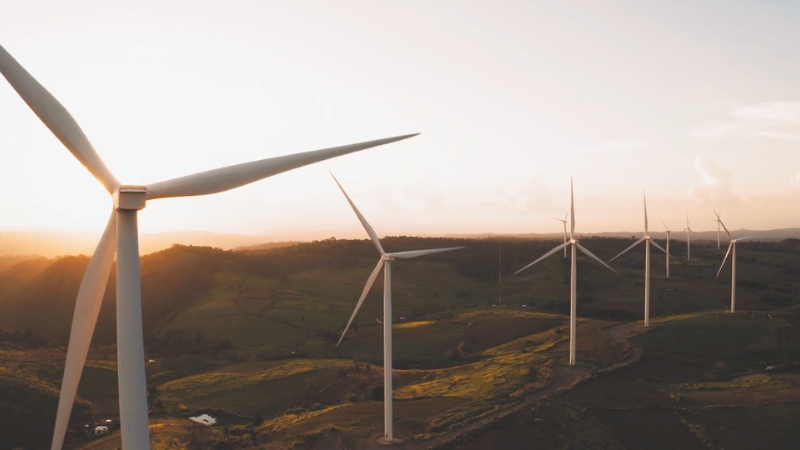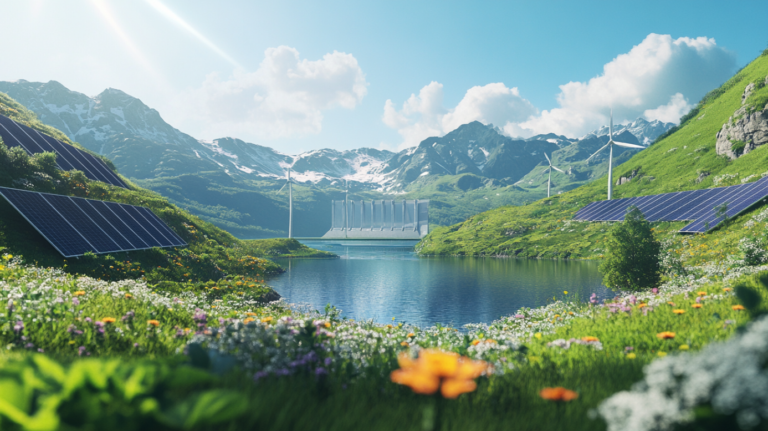In the race to power our planet sustainably, hydropower and wind energy stand as titans of renewable energy, each harnessing nature’s forces to light our homes and fuel our future.
But which is truly more sustainable?
After looking at the data, wind energy emerges as the frontrunner, offering a lighter environmental footprint, lower costs, and fewer social disruptions compared to hydropower.
For instance, onshore wind boasts a levelized cost of energy (LCOE) of $39 per megawatt-hour in 2023, undercutting hydropower’s $60, while using less land per unit of electricity—0.5 to 1 m² versus hydropower’s 1 to 1,000 m² according to the IRENA report.
Yet, the answer isn’t black-and-white—hydropower’s grid stability and regional advantages keep it in the game.
Environmental Sustainability: Ecosystems and Land Use
Sustainability begins with environmental impact, and here, the two energy sources diverge significantly. Hydropower, particularly large-scale projects involving dams, can profoundly alter ecosystems.
According to the U.S. Energy Information Administration (EIA), dam construction changes river ecosystems by obstructing fish migration, altering water temperatures, and flooding natural habitats.
A 2017 study from ScienceDaily goes further, labeling hydropower as the most dangerous among “green” energy sources due to its degradation of biologically rich habitats, especially in tropical rainforests
Reservoirs created by dams can also emit methane—a potent greenhouse gas—complicating hydropower’s carbon-neutral claims, as noted in a lifecycle assessment review (ScienceDirect, 2022).
Wind energy, by contrast, has a lighter ecological footprint. While wind turbines do pose risks—killing up to 328,000 birds annually in North America, according to Innovation News Network — these impacts are often site-specific and mitigated.
Unlike hydropower, wind farms allow dual land use, such as farming or grazing, minimizing habitat loss. However, a comparative lifecycle assessment in China suggests wind power may have higher impacts in categories like acidification and human toxicity compared to hydropower.
Globally, though, wind’s effects are less severe than the widespread habitat destruction caused by large dams.
Land use efficiency further highlights the disparity. As reported by Our World in Data, onshore wind requires 0.5 to 1 m² per MWh of electricity, while hydropower ranges from 1 to 10 m² per MWh, with some projects ballooning to 1,000 m² per MWh due to reservoir flooding.
The UNECE’s lifecycle assessment reinforces this, noting hydropower’s variability stems from reservoir size, while wind’s larger farm area (8 to 184 m² per MWh) still permits co-use.
Below is a table summarizing these differences:
Energy Source
Land Use (m² per MWh)
Environmental Notes
Hydropower
1 to 1,000
High variability; floods habitats, emits methane
Wind Energy
8 to 184
Allows dual use; impacts birds but less ecosystem disruption
Climate change adds another layer. The IPCC’s SRREN report indicates hydropower’s technical potential may shift regionally with climate impacts, while wind’s global potential remains stable, though distribution may change.
Hydropower’s reliance on water availability makes it more vulnerable to droughts, potentially undermining its long-term sustainability.
Economic Sustainability: Costs and Job Creation
View this post on Instagram
Economic viability is a cornerstone of sustainability, and here, wind energy often takes the lead. The International Renewable Energy Agency (IRENA) reports that in 2023, the global weighted average levelized cost of energy (LCOE) for onshore wind was $39/MWh, compared to $60/MWh for hydropower.
Lazard’s LCOE+ analysis aligns with this, showing wind’s competitiveness even amidst high interest rates. Hydropower’s low operational costs are offset by massive upfront investments—dam construction can cost billions, making it less flexible in a rapidly evolving energy market.
Job creation also favors wind. The EIA notes that wind added 10 GW of capacity in the U.S. in 2019, signaling robust job growth in construction and maintenance. Hydropower, with fewer new large projects planned, offers less potential for new employment.
However, hydropower’s dispatchable nature—its ability to provide power on demand—offers grid stability, potentially reducing the need for costly backup systems, as highlighted by WindCycle. Wind’s intermittency, conversely, necessitates storage solutions, adding to its economic burden.
Here’s a cost comparison table:
Energy Source
LCOE ($/MWh, 2023)
Economic Notes
Hydropower
60
High upfront costs, low operational costs, and grid stability
Wind Energy
39
Lower LCOE requires storage, and rapid job growth
Social Sustainability: Communities and Acceptance

Social sustainability hinges on how energy projects affect people. Hydropower’s social footprint is often heavy. Large dams can displace entire communities, alter local economies, and disrupt cultural heritage, as noted in a holistic sustainability assessment.
While it offers benefits like flood control and irrigation, these come at a steep human cost. Canadian Hydro Beyond points out that such disruptions can outweigh the advantages in densely populated regions.
Wind energy, while not without challenges, fares better socially. Opposition often centers on visual and noise pollution, turbines are frequently called eyesores, but these issues are less disruptive than displacement. The IPCC SRREN report suggests technical and institutional solutions can mitigate public resistance.
Moreover, wind farms create jobs and provide land lease income, boosting local economies, as Environment.co observes.
Below is a social impact summary:
Energy Source
Social Impacts
Community Benefits
Hydropower
Displacement, cultural loss
Flood control, irrigation
Wind Energy
Visual/noise pollution
Jobs, land lease income
The Verdict: Wind Edges Out Hydropower
@armchairengineer Did you know wind power works together with hydropower? #hydropower #windpower #windfarm #solarenergy #cleanenergy #greenenergy #climatechangeisreal ♬ original sound – Armchair Engineer
After weighing the evidence, wind energy emerges as the more sustainable option in most contexts. Environmentally, its lower land use per unit of energy and reduced ecosystem disruption give it an edge over hydropower’s habitat-altering dams.
Economically, wind’s lower LCOE and job creation potential outshine hydropower’s high initial costs, despite the latter’s grid reliability. Socially, wind avoids the severe community displacement tied to large hydropower projects, offering instead economic benefits with manageable drawbacks.
That said, the comparison isn’t absolute. In specific regions, hydropower’s lifecycle emissions may be lower, as a China-based study suggests, and its ability to store energy gives it a niche advantage.
Context matters—mountainous regions with abundant water may favor hydropower, while open plains suit wind. Yet, on a global scale, wind energy’s scalability, lower impact, and cost-effectiveness make it the frontrunner.
Conclusion: A Sustainable Future

Both hydropower and wind energy are vital to a renewable future, but sustainability demands a nuanced view. Wind energy, with its lighter environmental footprint, economic advantages, and lesser social disruption, generally aligns better with long-term goals.
As we navigate the energy transition, prioritizing wind, while leveraging hydropower’s strengths where feasible, could pave the way for a cleaner, more equitable world.

